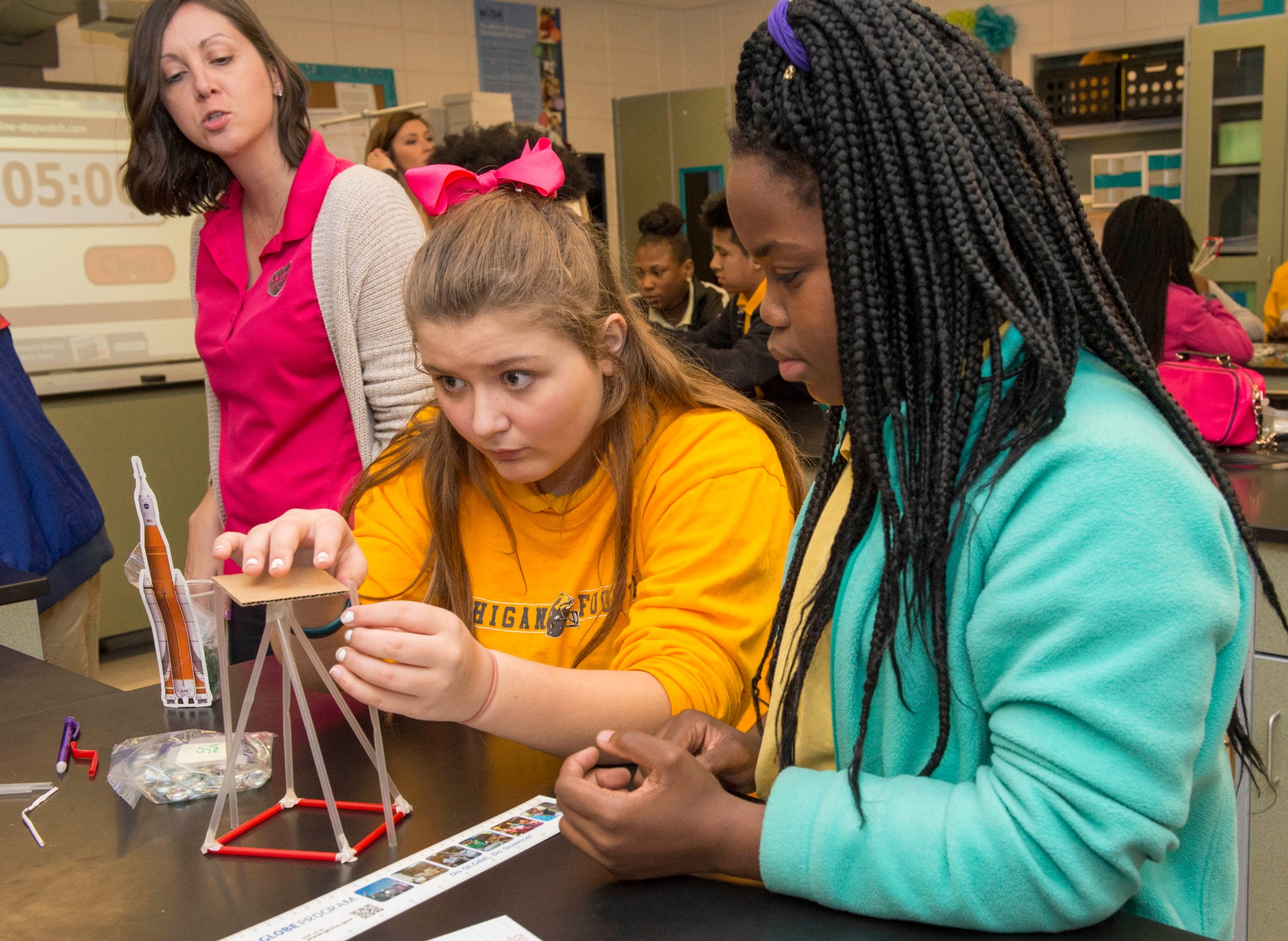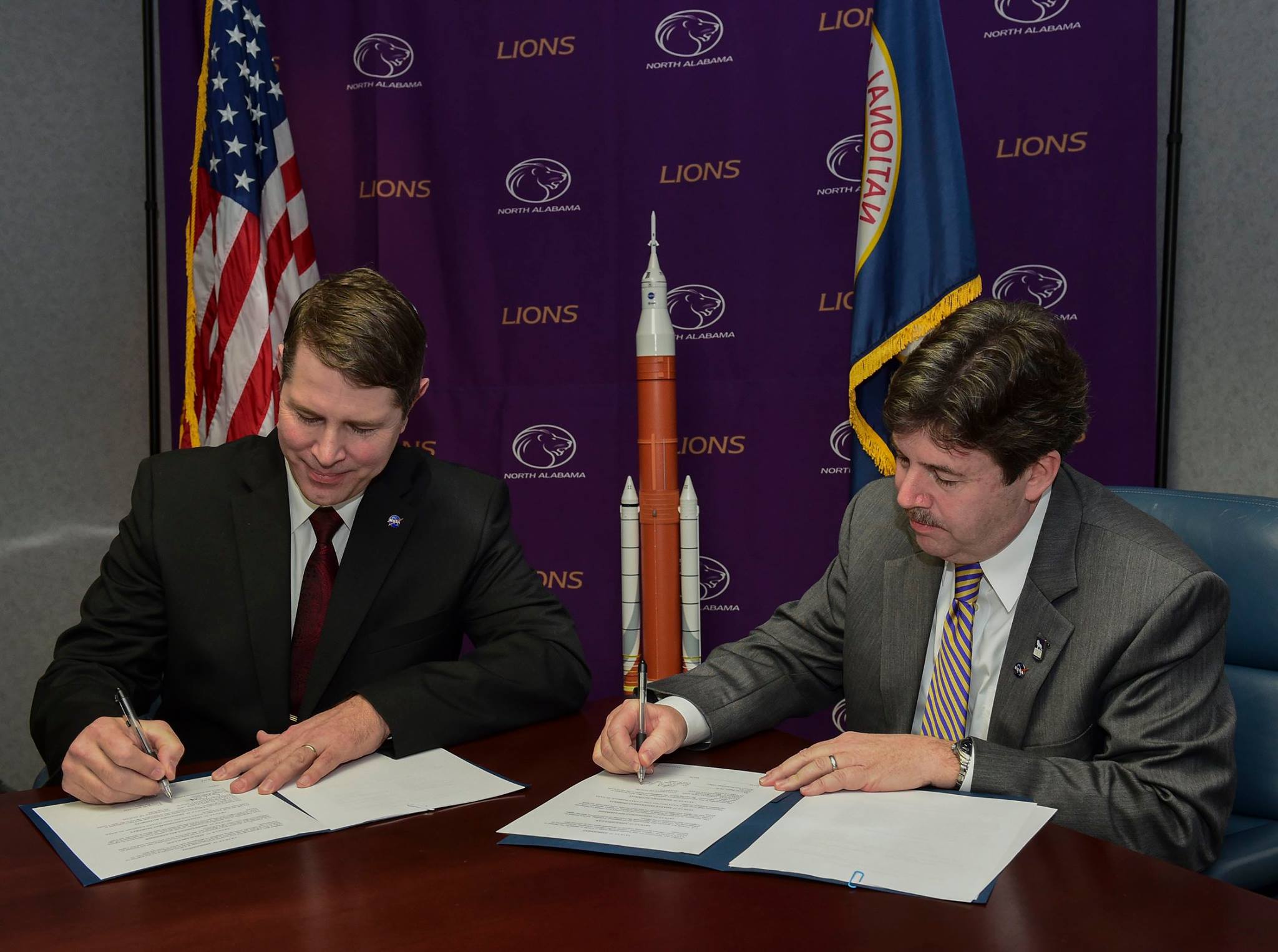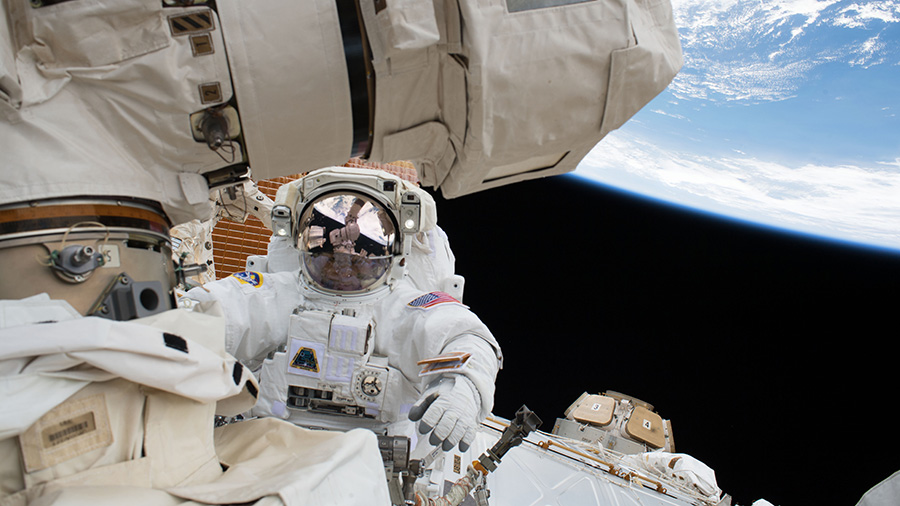In This Week’s Star
- Marshall Outreach Spans All 67 Alabama Counties
- Marshall Scientists Study Snow at the Winter Olympics
- Spacewalkers Wrap Up Robotic Hand Transfers
- Faster, Easier New Technology Reporting System Released
- This Week in NASA History: STS-82 Lands – Feb. 21, 1997
- State of NASA Highlighted on ‘This Week @NASA’
- Obituaries
Marshall Outreach Spans All 67 Alabama Counties
By Jonathan Deal
Whether it was through the extensive outreach to teachers and students, by fostering scores of small business opportunities, through research partnerships advancing aerospace technologies, or the hundreds of speaking engagements by NASA subject matter experts across the state, Marshall Space Flight Center’s impact on Alabama knew no bounds last year.
“Soon after becoming center director, I noticed we consistently reached about two-thirds of the state and challenged the team to extend our reach to every county,” said Marshall Center Director Todd May. “Alabama has long been committed to NASA and to helping us achieve our space exploration goals. We are equally committed to extending our knowledge and the benefits of NASA’s science and technology investments to provide the greatest benefit across Alabama, and across the nation.”

Through special contracts called Space Act Agreements, NASA partners to share resources, personnel and expertise, facilities and equipment, and technology to advance aerospace research or achieve mission goals. Currently, Marshall has more than 50 active Space Act Agreements with industry, academic, non-profit and other government agencies based in Alabama including the University of Alabama System, Auburn University, Alabama A&M University in Huntsville and the University of North Alabama in Florence.
Students throughout Alabama, across the country and around the world take advantage of some of the unique, challenging competitions offered through Marshall, such as the Human Exploration Rover Challenge and Student Launch Initiative. In addition, students nationwide can take advantage of various grants, fellowships and internships offered through Marshall.
And it’s not just through institutions of higher learning that Marshall is making an impact. The business of NASA reaches every corner of the state through Marshall’s award-winning small business program. In 2017 alone, the Small Business Innovation Research Program awarded 10 research grants to Alabama companies that will play integral roles supporting five different NASA centers across the United States.
A big part of Marshall’s ability to reach all 67 Alabama counties was done through a STEM Education and Accountability Project grant called NASA Network of States, which provides systemic, long-term support for NASA centers and partners by building strong regional networks for NASA educator professional development. Through Network of States, Marshall officials hosted and successfully completed the initial training of 84 teachers representing the 11 education regions in Alabama.

Four of the teachers who received the training will support Marshall’s annual NASA Day in Montgomery outside the Capitol Feb. 22, offering a hands-on engineering activity to visitors walking through the exhibits. The annual event which is open to the public celebrates the historic role Marshall played in NASA’s success and recognizes Alabama’s role in the agency’s journey to the Moon, Mars and beyond.
Following intensive training in which the teachers toured Marshall and received instruction from subject matter experts, those trained teachers then offered guidance in their respective regions. To date, more than 100 educators for grades K-12 have attended training with teachers who have completed the NASA training.
Susan Currie, an education specialist at Marshall, arranged for NASA officials to visit schools in Choctaw, Marengo and Perry counties, thanks to the interest of a helpful 4-H coordinator in rural Alabama. Currie had previously had little response from schools in that area, but after connecting with Jacqui James, a county extension agent representing those counties, Marshall set up outreach activities in that part of the state.
Another way NASA reaches diverse and far-reaching communities throughout Alabama is sending subject matter experts in engineering, project management, science and technology to speak to community civic and professional clubs. One example was in February 2017 in Wilcox County, the home county of Alabama Gov. Kay Ivey, when Marshall team members spent the morning with 100 eighth-graders, talking about the long history of NASA in Alabama — and the exciting future students could be a part of.
“Education of our youth is the key to the future,” said May, “and Marshall continues to promote outreach efforts across the state and region to inspire the next generation of potential scientists, engineers and space explorers. This is critical to developing a viable STEM workforce in Alabama and across our country. We’ve now finally reached all 67 counties, and we’ll continue in our outreach to go back and reinvigorate different places within those counties in the coming years.”
Deal, an ASRC Federal/Analytical Services employee and Marshall Star Editor, supports the Office of Strategic Analysis & Communications.
Marshall Scientists Study Snow at the Winter Olympics
NASA Marshall Space Flight Center scientists have their eyes on Olympic slopes, tracks and halfpipes, but they’re not just watching skiers take flight. They’re tracking snow over PyeongChang’s tricky terrain to figure out how well we can measure it from space and provide better data for snowstorm predictions.
NASA is one of 20 agencies from about a dozen countries participating in a project called the International Collaborative Experiments for PyeongChang 2018 Olympic and Paralympic Winter Games, or ICE-POP, led by the Korean Meteorological Administration. NASA and the international team have been making measurements since the start of the Olympics on Feb. 9 and will continue through the end of the Paralympics on March 18.
“We are interested in South Korea because we can improve our understanding of the physics of snow in mountainous areas to help improve the accuracy of our observations and models,” said Walt Petersen, research scientist with Marshall’s Earth Science Branch.
Petersen is in charge of coordinating NASA’s ground instruments and science for ICE-POP 2018. NASA is contributing 11 instruments — weather radars, snow imagers, gauges — as well as satellite imagery and products from the Global Precipitation Measurement mission.
GPM is an international mission led by NASA and the Japan Aerospace Exploration Agency consisting of a network of satellites that provide the next-generation global observations of rain and snow to advance our understanding of Earth’s water and energy cycle, improve forecasting of extreme events and provide accurate and timely information to directly benefit society. ICE-POP collaboration will help verify GPM satellite estimates of snowfall, and enable studies of snow properties.
Also, Marshall’s Short-term Prediction Research and Transition Center — SPoRT — is providing experimental forecasts that the Korean Meteorological Administration can use with other Korean and international forecast model inputs. Near real-time feedback from the KMA will help the SPoRT team advance its forecast model.
“When you run these models together from the different agencies, you can see how one model behaves versus another one,” said Brad Zavodsky, the project manager for SPoRT. “You learn a great deal about your abilities to predict in a forecast model and how to improve it.”
“If we get an improved model, it opens the possibility of using the model to help improve satellite-based methods for estimating snowfall, and more generally, improves our understanding of clouds, climate, and the water and energy cycles,” Petersen said.
Spacewalkers Wrap Up Robotic Hand Transfers

Expedition 54 Flight Engineers Mark Vande Hei of NASA, and Norishige Kanai of the Japan Aerospace Exploration Agency completed a spacewalk at 11:57 p.m. CST, Feb. 16, of 5 hours and 57 minutes, with repressurization of the Quest airlock. The spacewalkers moved two Latching End Effector, or hands, for the Canadian-built robotic arm, Canadarm2. During the extra vehicular activity, they moved one hand to a long-term storage location for future use as a spare part and brought the other inside the International Space Station to be returned to Earth. It will be refurbished and later relaunched to the orbiting laboratory as a spare. Running well ahead of the timeline, the two spacewalkers also conducted a number of get ahead tasks, including the lubrication of the inside of the Latching End Effector, installed on the station’s robotic arm during a Jan. 23 spacewalk. Here, during that spacewalk, Vande Hei begins maintenance work on the Canadarm2. They also positioned an interface tool for the Canadian Space Agency’s robotic handyman — Dextre — and adjusted a strut on a component on one of the station’s spare parts platforms. It was the 208th spacewalk in support of space station assembly and maintenance, the fourth in Vande Hei’s career and the first for Kanai, who became the fourth Japanese astronaut to walk in space. (NASA)
Faster, Easier New Technology Reporting System Released
The NASA Technology Transfer Program has made submitting New Technology Reports faster and easier than ever before. The new, streamlined electronic reporting system — e-NTR — uses an automated series of simple questions to guide you through the reporting process.
Created with NASA inventors in mind, the number of data fields in e-NTR was significantly decreased from its predecessor to help shorten completion time and focus only on required information.
The ultimate goal is to help turn technologies into commercial products that benefit NASA and the nation by licensing them to companies — and it all starts with a New Technology Report.
As another incentive to report, inventors can also earn royalty income up to $150,000 per year if their patented technologies are licensed and commercialized by companies.
To check out the new system made just for NASA inventors, visit https://invention.nasa.gov/.
This Week in NASA History: STS-82 Lands – Feb. 21, 1997

This week in 1997, space shuttle Discovery, mission STS-82, landed safely at NASA’s Kennedy Space Center, completing the second Hubble Space Telescope servicing mission. Here, former NASA astronaut Steven L. Smith is servicing the orbiting telescope. NASA’s Marshall Space Flight Center was responsible for the design, development and construction of the telescope. Hubble was designed with these types of on-orbit servicing missions in mind as a way of extending the telescope’s lifespan. Today, Marshall is responsible for mirror technology development and environmental research on the James Webb Telescope — the world’s next-generation space observatory and successor to Hubble. The NASA History Program is responsible for generating, disseminating and preserving NASA’s remarkable history and providing a comprehensive understanding of the institutional, cultural, social, political, economic, technological and scientific aspects of NASA’s activities in aeronautics and space. For more pictures like this, and to connect to NASA’s history, visit the Marshall History Program’s webpage. (NASA)
State of NASA Highlighted on ‘This Week @NASA’
The 2018 State of NASA address delivered by acting Administrator Robert Lightfoot at Marshall Space Flight Center is featured in “This Week @NASA,” a weekly video program broadcast nationwide on NASA-TV and posted online.
During his Feb. 12 address, NASA Acting Administrator Robert Lightfoot discussed the significance of President Donald Trump’s $19.9 billion fiscal year 2019 budget request for the agency.
“It really reflects the administration’s confidence that America will lead the way back to the Moon, and take that next giant leap from where we made the first small step for humanity some 50 years ago,” said Lightfoot.
Lightfoot also thanked employees and attributed the confidence reflected in the budget to the work of thousands of people. “You always come through. We have one mission success after another,” he added. “And because of that, I say, ‘the state of NASA is strong!’”
View this and previous episodes at “This Week @NASA” on NASA’s YouTube page.
Obituaries
Charles H. Jackson, 81, of Decatur, Alabama, died Feb. 12. He retired from the Marshall Center in 1994 as a materials engineer. He is survived by his wife, Judith K. Jackson.



























